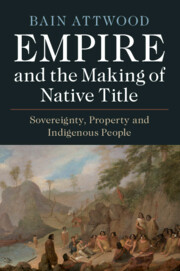Book contents
- Empire and the Making of Native Title
- Empire and the Making of Native Title
- Copyright page
- Dedication
- Contents
- Acknowledgements
- Abbreviations
- Principal Players
- Maps
- Introduction
- 1 Claiming Possession in New Holland and New Zealand, 1770s–1820s
- 2 Batman’s Treaty and the Rise and Fall of Native Title, 1835–1836
- 3 The South Australian Colonisation Commission, the Colonial Office and Aboriginal Rights in Land, 1834–1837
- 4 Protection Claims and Sovereignty in the Islands of New Zealand, 1800–1839
- 5 Making Agreements and a Struggle for Authority, 1839–1840
- 6 The Land Claims Commission and the Return of the Treaty, 1840–1843
- 7 A Colony in Crisis and a Select Committee, 1843–1844
- 8 The Retreat of the Government and the Rise of the Treaty, 1844–1845
- 9 The Making of Native Title, 1845–1850
- Conclusion
- Appendix: The English Text of the Treaty of Waitangi
- Bibliography
- Index
5 - Making Agreements and a Struggle for Authority, 1839–1840
Published online by Cambridge University Press: 03 July 2020
- Empire and the Making of Native Title
- Empire and the Making of Native Title
- Copyright page
- Dedication
- Contents
- Acknowledgements
- Abbreviations
- Principal Players
- Maps
- Introduction
- 1 Claiming Possession in New Holland and New Zealand, 1770s–1820s
- 2 Batman’s Treaty and the Rise and Fall of Native Title, 1835–1836
- 3 The South Australian Colonisation Commission, the Colonial Office and Aboriginal Rights in Land, 1834–1837
- 4 Protection Claims and Sovereignty in the Islands of New Zealand, 1800–1839
- 5 Making Agreements and a Struggle for Authority, 1839–1840
- 6 The Land Claims Commission and the Return of the Treaty, 1840–1843
- 7 A Colony in Crisis and a Select Committee, 1843–1844
- 8 The Retreat of the Government and the Rise of the Treaty, 1844–1845
- 9 The Making of Native Title, 1845–1850
- Conclusion
- Appendix: The English Text of the Treaty of Waitangi
- Bibliography
- Index
Summary
The significance of the treaty made at Waitangi in 1840 has consistently been exaggerated by historians. All the British players involved in making it were preoccupied with the momentary diplomatic task of persuading the chiefs to cede sovereignty to the British Crown. The inclusion in the agreement of a clause confirming the natives in the possession of their lands did not spring from the British government’s instructions but from the influence of local rather than metropolitan actors and forces. Moreover, with one exception, there is no contemporary evidence that any parties attached the significance to the first clause of its second article that was attributed to it later. What is more, the British government eventually claimed possession of the larger part of New Zealand on the very same basis as it had assumed possession of New South Wales in 1788, namely the doctrine of discovery. The way in which critical matters relating to land title were treated at the imperial centre was fundamentally a function of political power and could readily change according to circumstances. The government bowed to the pressure that a group of adventurers, the New Zealand Company, was able to exert in parliament and the press.
Keywords
- Type
- Chapter
- Information
- Empire and the Making of Native TitleSovereignty, Property and Indigenous People, pp. 140 - 196Publisher: Cambridge University PressPrint publication year: 2020



